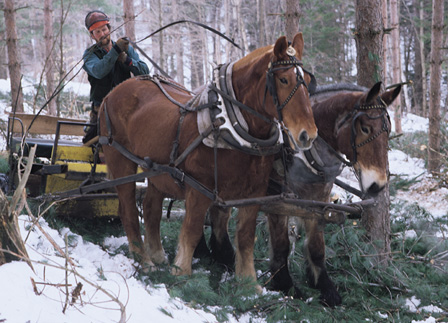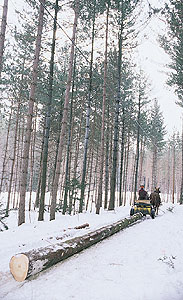
| SEARCH |
| YELLOW PAGES |
| WHITE PAGES |
| UVM HOME |


Russell’s passion for working in the forest started when he was eleven years old. His first work was pulling brush while his father chopped wood at their Bethel home. The weekends he spent doing chores on his family’s land were the start of his strong relationship with the environment and led to his decision to study forestry at UVM.
Russell spent his first four years after graduation working as a forester at a local sawmill, Mann Brothers Lumber, in Royalton, Vermont. “I took the job with the idea that I’d go into the industry myself…I needed to know what the industry was about.” At Mann Brothers, Russell learned the basics of networking and forest management. His first job at the mill was measuring logs, determining their volume, detecting defects, and grading the lumber. His next job was surveying plots of forest that the mill was interested in logging.
While working at the sawmill Russell noticed a logger using horses instead of the standard skidder. “I was on my way to New England Equipment to buy a bulldozer when I saw a guy using his horses. I never went back,” he says, smiling.
Horses are Russell’s way of promoting and practicing sustainable
forestry. “I’m showing a way in which we can practice low-impact
ecological forestry in a cost-effective and practical way.” Ben
and Peg cost $2.50 per head per day for feed, harness, vetting,
shoes, and any other odds and ends that might come up. 
Ben and Peg are less than half the weight of the typical skidder and do far less damage to the ground when they are working. Skidders can measure up to sixteen feet wide, forcing the logger to clear a much bigger path than a horse logger would use. The weight of the massive skidder churns up the ground when its wheels turn, tearing up the surface of the forest. Although Russell cannot log an area as quickly as loggers with skidders, the relatively inexpensive upkeep for the horses and the fact that the horses do much less damage to the ground makes logging worth his while as a businessman and an environmentalist.
“To me, animals are so practical for the work. You need to expect cooperation from the animals and I’ve found I can get it.” Russell’s horses respond to a number of simple one-word commands. He says “Woah” when he wants them to stop, “Gee” when they should move to the right, “Haw” when they should move to the left, and other directional commands. “I try not to chatter with them and I always try and give them a chance to respond before I say another command.”
Russell is sensitive to his horses’ needs. He stops to rest them before they would feel the need to stop on their own. “It is better to go light and often than wear them out with a heavy load.” He never pushes them beyond their limits, never raises his voice with them or physically harms them. They are as much a part of his business as he is.
Before making the commitment to logging with horses, Russell did anything he could to expose himself to draft horses. “I’d go to pulling events and plowing contests, and I’d search out places where teamsters were.” He read The Work Horse Handbook and The Draft Horse Primer and took any advice he could get from other draft horse owners. He admits that he is more of a “hands-on-experience learner” though. It took an enormous amount of patience and encouragement to get the horses to the point where they are now. “If you’re in a hurry with animals, you should have gotten started two weeks sooner,” he says with a chuckle.
Russell and his horses work long and demanding hours, both on his own land and for private landowners nearby. Russell drives the horses standing in a two-wheeled cart. Like the driver of a chariot, he stands tall, guiding the horses with the reins and with his voice. The team strides through the woods, the cart bumping along over tree stumps and whatever else might be on the ground. Once they reach the work area, Russell secures the horses, with a chain wrapped around a tree and the harness, in the distance, and heads over to the first tree he will cut. Ben and Peg stand patiently as Russell chips a wedge out of the base of the tree, allowing him to control where the tree will fall. He then drives a plastic wedge into the opposite side of the trunk where he cut the initial wedge. Helmet, eye mask, and ear mufflers on, Russell grinds through the trunk with the sharp teeth and roar of his chain saw. As the tree crashes down, I glance over at Ben and Peg, who seem to be enjoying the sunshine, unaffected by the mighty crash.
In a matter of seconds, Russell zips up and down the fallen tree, buzzing branches off the trunk. He attaches one end of a measuring tape to the base of the log and measures out two sixteen-foot pieces and one twelve-foot piece. The logs are cut and Ben and Peg are called back into action. Russell swiftly unties the horses, hops back in the cart and backs the cart and horses up to the exact spot where the logs begin. He secures the logs with chains attached to a bobsled that glides along the ground. The sled angles the logs off the ground minimizing drag that would tear up the ground.
Ben and Peg march side by side with the grace of a pair of figure skaters. They respond to Russell’s commands without any hesitancy. Each stride they make is strong, powerful, and purposeful. They are just as accustomed to the forest and Russell’s work, as they are to the hay, grain, and fresh water they enjoy every morning. The chainsaw and the falling trees do not frighten them. Their ears perk forward. They are alert, “incredibly aware of what’s going on.”
Russell, Ben, and Peg do not need to advertise. They only work for private landowners who seek out an ecologically sound forest. “I don’t search out people. I’ve always got more work than I can do.”
Russell “wants people to take initiative to be involved in their own land.” Horse logging is a better option for private landowners because of its low impact on the land and the guarantee that Russell will leave them with a healthy forest, “not a lot of standing boards,” or dead trees.
“The primary ecological purpose for trees is to build soil.” Russell ensures this by leaving all of the branches and brush in the forest that he trims from the logs that he takes away. It is pointless to groom the forest for aesthetic reasons if it will rob the soil of the nutrients it needs to keep the forest alive.
He adds, “Most people are more interested in a healthy forest than timber production.” His clients can expect the timber they need as well as a sustainable forest. “The ecological objects of the forest become your primary objective.” VQ
Elizabeth Pope is an English major from South Dartmouth, Massachusettes and will graduate in May 2000.